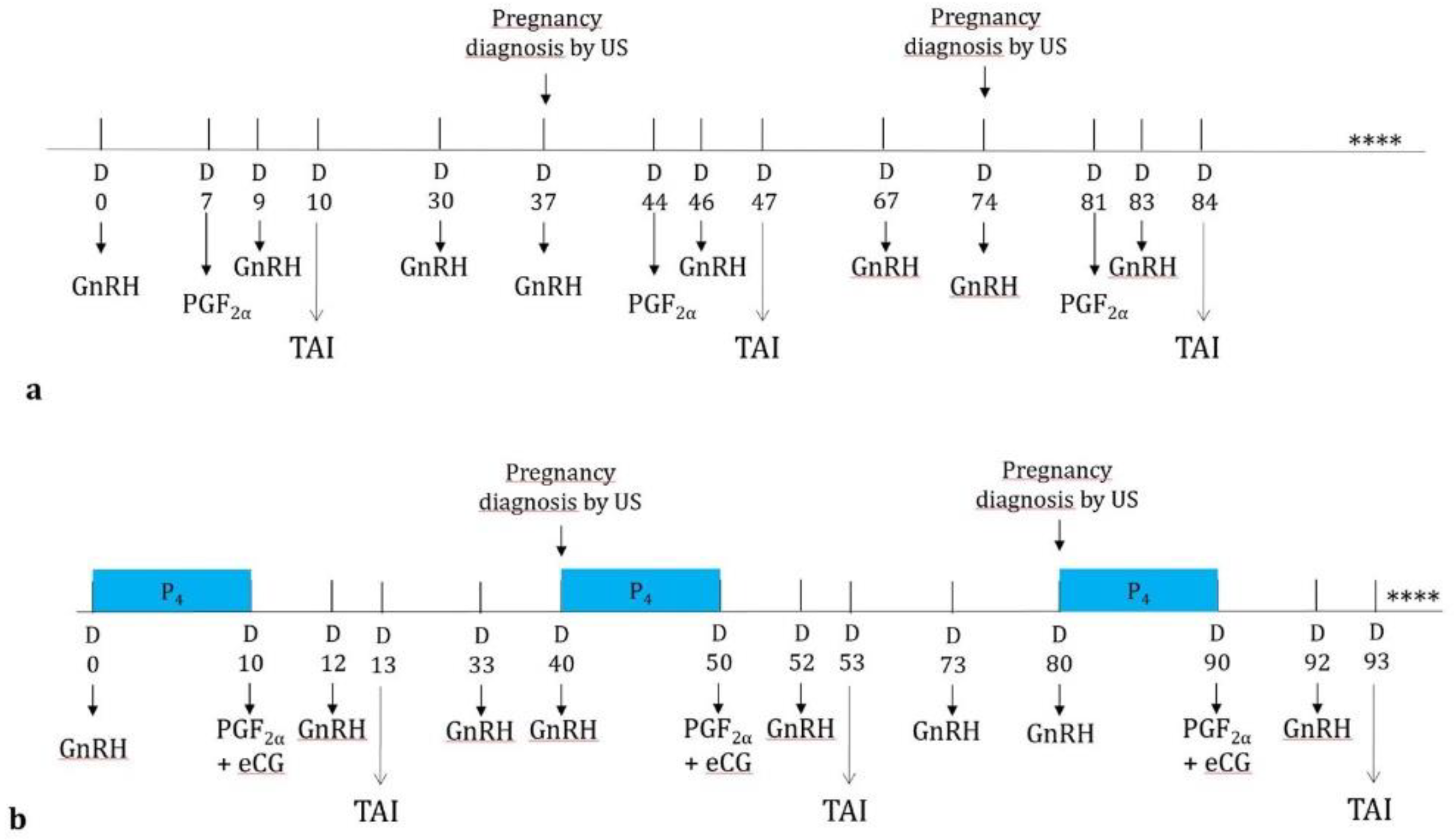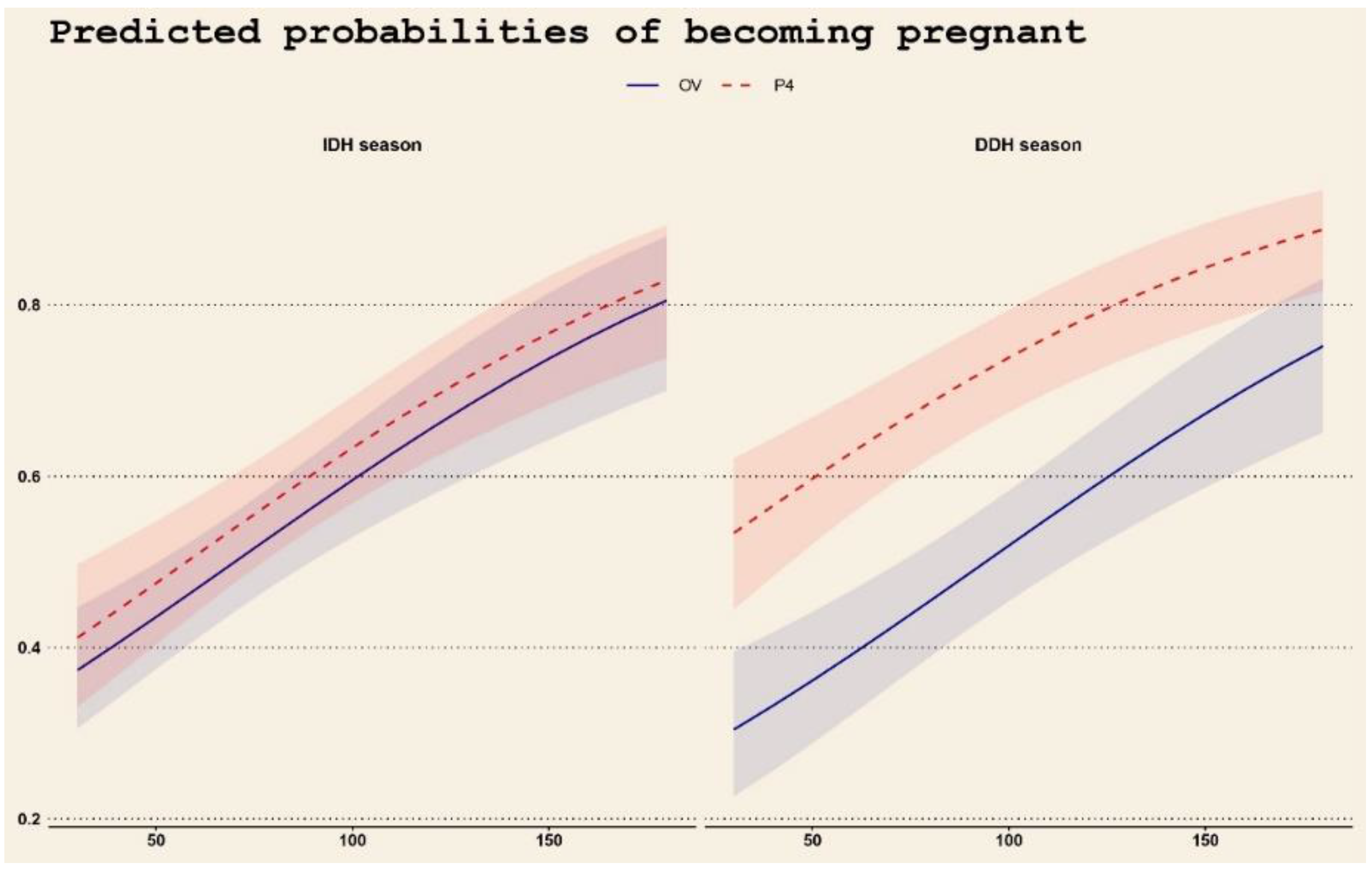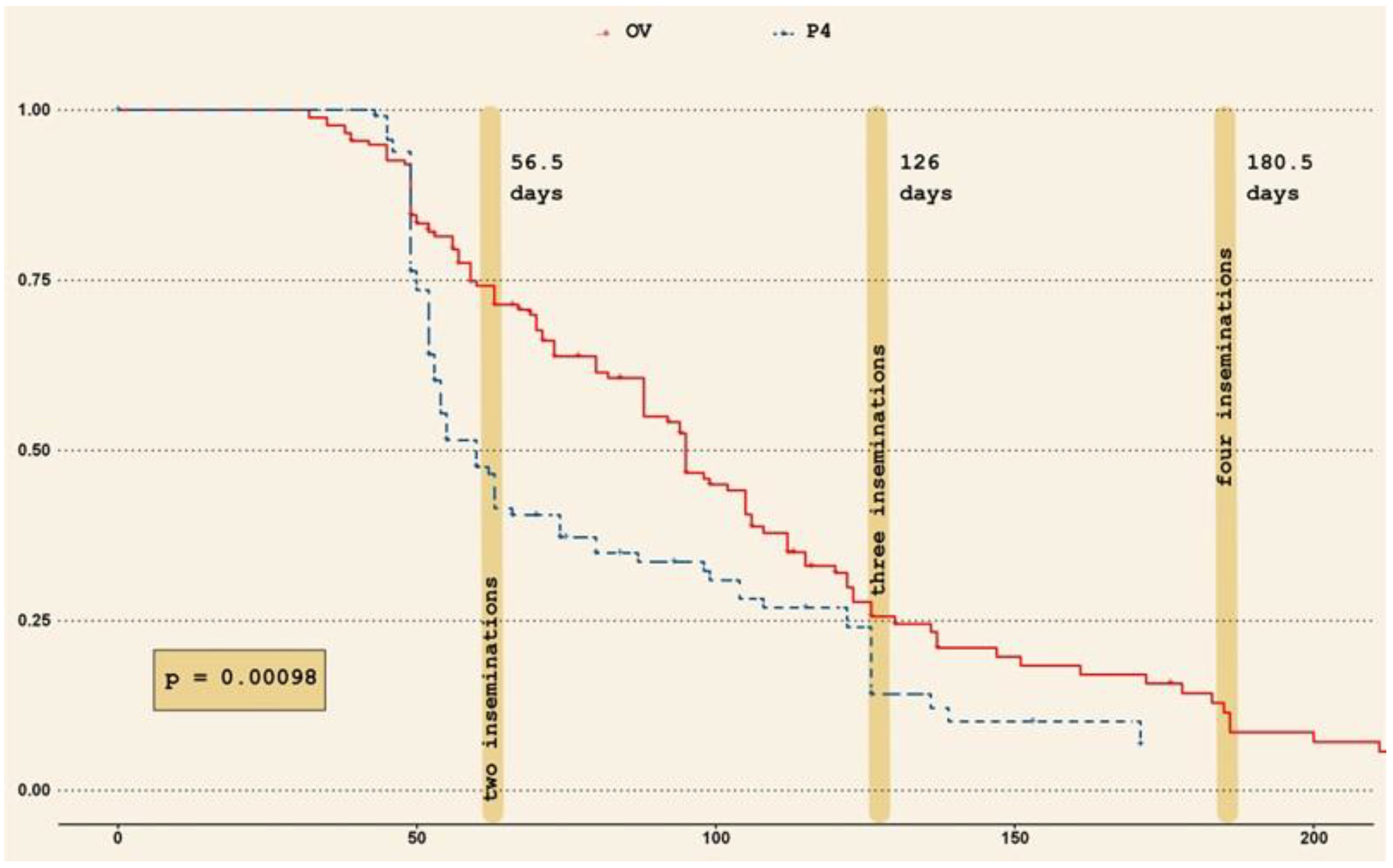Pregnancies following Protocols for Repetitive Synchronization of Ovulation in Primiparous Buffaloes in Different Seasons
Abstract
Simple Summary
Abstract
1. Introduction
2. Materials and Methods
2.1. Farm Management and Animals
2.2. Experimental Design: First Synchronization Treatments, TAI and Ultrasound
- Group OV underwent an Ovsynch-TAI program [14]. Briefly, a GnRH analogous (buserelin acetate, 12 mg; Receptal®, Intervet, Milan, Italy) was administered on day 0, followed by a PGF2α (dinoprost; Dinolytic®, Zoetis, Milan, Italy) on day 7 and a second GnRH administration on Day 9. Timed AI was carried out on day 10 at 60 h and 16 h after PGF2α and the last GnRH administration.
- Group P4 was treated by a progesterone (P4) based protocol [16]. Briefly, the animals received a GnRH analogous (buserelin acetate, 12 mg; Receptal®, Intervet, Milan, Italy) administration on Day 0, together with the insertion of aP4-based intravaginal device (CIDR®, Zoetis, Milan, Italy), that was maintained for 10 days. On the day of device removal (Day 10), both 750 IU of equine chorionic gonadotrophin (eCG; Folligon®, Intervet MSD, Milan, Italy) and 25 mg of dinoprost (Dinolytic®, Zoetis, Milan, Italy) were administered, followed two days later (Day 12) by an administration of GnRH analogous (buserelin acetate, 12 mg; Receptal®, Intervet, Milan, Italy). Timed AI was also performed in this case 60 h and 16 h after PGF2α and GnRH administration, respectively.
2.3. Experimental Design: Re-Synchronization
2.4. Statistical Analysis
3. Results
3.1. Farm Management and Animals
3.2. Synchronization Protocols and Pregnancies following the First AI
3.3. Synchronization Protocols and Pregnancies following Consecutive AIs
4. Discussion
5. Conclusions
Author Contributions
Funding
Institutional Review Board Statement
Informed Consent Statement
Data Availability Statement
Conflicts of Interest
References
- Srirattana, K.; Hufana-Duran, D.; Atabay, E.P.; Duran, P.G.; Atabay, E.C.; Lu, K.; Liang, Y.; Chaikhun-Marcou, T.; Theerakittayakorn, K.; Parnpai, R. Current status of assisted reproductive technologies in buffaloes. Anim. Sci. J. 2022, 93, e13767. [Google Scholar] [CrossRef] [PubMed]
- Moore, S.G.; Hasler, J.F. A 100-Year Review: Reproductive technologies in dairy science. J. Dairy Sci. 2017, 100, 10314–10331. [Google Scholar] [CrossRef] [PubMed]
- Baruselli, P.S.; Soares, J.G.; Bayeux, B.M.; Silva, J.C.B.; Mingoti, R.D.; Carvalho, N.A.T. Assisted reproductive technologies (ART) in water buffaloes. Anim. Reprod. 2018, 15 (Suppl. S1), 971–983. [Google Scholar] [CrossRef] [PubMed]
- Neglia, G.; De Nicola, D.; Esposito, L.; D’Occhio, M.J.; Fatone, G. Reproductive management in buffalo by artificial insemination. Theriogenology 2020, 150, 166–172. [Google Scholar] [CrossRef]
- Nanda, A.S.; Brar, P.S.; Prabhakar, S. Enhancing reproductive performance in dairy buffalo: Major constraints and achievements. Reprod. Suppl. 2003, 61, 27–36. [Google Scholar] [CrossRef] [PubMed]
- de Carvalho, N.A.; Soares, J.G.; Baruselli, P.S. Strategies to overcome seasonal anestrus in water buffalo. Theriogenology 2016, 86, 200–206. [Google Scholar] [CrossRef]
- Perera, B.M. Reproductive cycles of buffalo. Anim. Reprod. Sci. 2011, 124, 194–199. [Google Scholar] [CrossRef]
- Das, G.K.; Khan, F.A. Summer anoestrus in buffalo—A review. Reprod. Domest. Anim. 2010, 45, e483–e494. [Google Scholar] [CrossRef]
- Zicarelli, L. Enhancing reproductive performance in domestic dairy water buffalo (Bubalus bubalis). Soc. Reprod. Fertil. Suppl. 2010, 67, 443–455. [Google Scholar] [CrossRef]
- Campanile, G.; Baruselli, P.S.; Neglia, G.; Vecchio, D.; Gasparrini, B.; Gimenes, L.U.; Zicarelli, L.; D’Occhio, M.J. Ovarian function in the buffalo and implications for embryo development and assisted reproduction. Anim. Reprod. Sci. 2010, 121, 1–11. [Google Scholar] [CrossRef]
- D’Occhio, M.J.; Ghuman, S.S.; Neglia, G.; Della Valle, G.; Baruselli, P.S.; Zicarelli, L.; Visintin, J.A.; Sarkar, M.; Campanile, G. Exogenous and endogenous factors in seasonality of reproduction in buffaloes: A review. Theriogenology 2020, 150, 186–192. [Google Scholar] [CrossRef] [PubMed]
- Singh, I.; Balhara, A.K. New approaches in buffalo artificial insemination programs with special reference to India. Theriogenology 2016, 86, 194–199. [Google Scholar] [CrossRef] [PubMed]
- Pursley, J.R.; Mee, M.O.; Wiltbank, M.C. Sinchronization of ovulation in dairy cows using PGF2 and GnRH. Theriogenology 1995, 44, 915–923. [Google Scholar] [CrossRef]
- Neglia, G.; Gasparrini, B.; Salzano, A.; Vecchio, D.; De Carlo, E.; Cimmino, R.; Balestrieri, A.; D’Occhio, M.J.; Campanile, G. Relationship between the ovarian follicular response at the start of an Ovsynch-TAI program and pregnancy outcome in the Mediterranean river buffalo. Theriogenology 2016, 86, 2328–2333. [Google Scholar] [CrossRef]
- Barile, V.L.; Terzano, G.M.; Pacelli, C.; Todini, L.; Malfatti, A.; Barbato, O. LH peak and ovulation after two different estrus synchronization treatments in buffalo cows in the daylight-lengthening period. Theriogenology 2015, 84, 286–293. [Google Scholar] [CrossRef]
- Neglia, G.; Capuano, M.; Balestrieri, A.; Cimmino, R.; Iannaccone, F.; Palumbo, F.; Presicce, G.A.; Campanile, G. Effect of consecutive re-synchronization protocols for ovulation on pregnancy rate in buffalo (Bubalus bubalis) heifers out of the breeding season. Theriogenology 2018, 113, 120–126. [Google Scholar] [CrossRef]
- Barile, V.L. Technologies related with the artificial insemination in buffalo. J. Buffalo Sci. 2012, 1, 139–146. [Google Scholar] [CrossRef]
- Rossi, P.; Vecchio, D.; Neglia, G.; Di Palo, R.; Gasparrini, B.; D’Occhio, M.J.; Campanile, G. Seasonal fluctuations in the response of Italian Mediterranean buffaloes to synchronization of ovulation and timed artificial insemination. Theriogenology 2014, 82, 132–137. [Google Scholar] [CrossRef]
- Campanile, G.; Neglia, G.; D’Occhio, M.J. Embryonic and foetal mortality in River buffalo (Bubalus bubalis). Theriogenology 2016, 86, 207–213. [Google Scholar] [CrossRef]
- De Rensis, F.; López-Gatius, F. Protocols for Synchronizing Estrus and Ovulation in Buffalo (Bubalus Bubalis): A Review. Theriogenology 2007, 67, 209–216. [Google Scholar] [CrossRef]
- Wagner, J.J.; Lusby, K.S.; Oltjen, J.W.; Rakestraw, J.; Wettemann, R.P.; Walters, L.E. Carcass composition in mature Hereford cows: Estimation and effect on daily metabolizable energy requirement during winter. J. Anim. Sci. 1988, 66, 603–612. [Google Scholar] [CrossRef] [PubMed]
- Vitali, A.; Segnalini, M.; Bertocchi, L.; Bernabucci, U.; Nardone, A.; Lacetera, N. Seasonal pattern of mortality and relationships between mortality and temperature-humidity index in dairy cows. J. Dairy Sci. 2009, 92, 3781–3790. [Google Scholar] [CrossRef] [PubMed]
- Ahmad, N.; Arshad, U. Synchronization and resynchronization strategies to improve fertility in dairy buffaloes. Theriogenology 2020, 150, 173–179. [Google Scholar] [CrossRef] [PubMed]
- Agresti, A. Categorical Data Analysis. In Statistics in Medicine; Altman, D., Ed.; Wiley: New York, NY, USA, 1992; pp. 1791–1795. [Google Scholar] [CrossRef]
- Kleinbaum, D.G.; Klein, M. Survival Analysis; Springer: Berlin, Germany, 2012. [Google Scholar]
- Harrell, F., Jr. Regression Modeling Strategies; Springer: Berlin, Germany, 2016. [Google Scholar]
- Presicce, G.A.; Parmeggiani, A.; Senatore, E.M.; Stecco, R.; Barile, V.L.; De Mauro, G.J.; De Santis, G.; Terzano, G.M. Hormonal dynamics and follicular turnover in prepuberal Mediterranean Italian buffaloes (Bubalus bubalis). Theriogenology 2003, 60, 485–493. [Google Scholar] [CrossRef]
- Presicce, G.A.; Senatore, E.M.; Bella, A.; De Santis, G.; Barile, V.L.; De Mauro, G.J.; Terzano, G.M.; Stecco, R.; Parmeggiani, A. Ovarian follicular dynamics and hormonal profiles in heifer and mixed-parity Mediterranean Italian buffaloes (Bubalus bubalis) following an estrus synchronization protocol. Theriogenology 2004, 61, 1343–1355. [Google Scholar] [CrossRef]
- Presicce, G.A. Reproduction in the water buffalo. Reprod. Domest. Anim. 2007, 42, 24–32. [Google Scholar] [CrossRef]
- Perera, B.M. Reproduction in domestic buffalo. Reprod. Domest. Anim. 2008, 43, 200–206. [Google Scholar] [CrossRef]
- Gallab, R.S.; Hassanein, E.M.; Rashad, A.M.A.; El-Shereif, A.A. Maximizing the reproductive performances of anestrus dairy buffalo cows using GnRH analogue-loaded chitosan nanoparticles during the low breeding season. Anim. Reprod. Sci. 2022, 244, 107044. [Google Scholar] [CrossRef]
- Riaz, U.; Hassan, M.; Husnain, A.; Nveed, M.I.; Singh, J.; Ahmad, N. Effect of timing of artificial insemination in relation to onset of standing estrus on pregnancy per AI in Nili-Ravi buffalo. Anim. Reprod. 2018, 15, 1231–1235. [Google Scholar] [CrossRef]
- de Araujo Berber, R.C.; Madureira, E.H.; Baruselli, P.S. Comparison of two Ovsynch protocols (GnRH versus LH) for fixed timed insemination in buffalo (Bubalus bubalis). Theriogenology 2002, 57, 1421–1430. [Google Scholar] [CrossRef]
- Galon, N.; Zeron, Y.; Ezra, E. Factors affecting fertility of dairy cows in Israel. J. Reprod. Dev. 2010, 56, S8–S14. [Google Scholar] [CrossRef] [PubMed]
- Lucy, M.C. Reproductive loss in high-producing dairy cattle: Where will it end? J. Dairy Sci. 2001, 84, 1277–1293. [Google Scholar] [CrossRef]
- Inchaisri, C.; Hogeveen, H.; Vos, L.A.M.; van der Weijden, G.C.; Jorritsma, R. Effect of milk yield characteristics, breed, and parity on success of the first insemination in Dutch dairy cows. J. Dairy Sci. 2010, 93, 5179–5187. [Google Scholar] [CrossRef] [PubMed]
- Rocha, A.; Rocha, S.; Carvalheira, J. Reproductive parameters and efficiency of inseminators in dairy farms in Portugal. Reprod. Domest. Anim. 2001, 36, 319–324. [Google Scholar] [CrossRef]
- Melendez, P.; Pinedo, P. The association between reproductive performance and milk yield in Chilean Holstein cattle. J. Dairy Sci. 2007, 90, 184–192. [Google Scholar] [CrossRef]
- Ramoun, A.A.; Emara, A.M.; Heleil, B.A.; Darweish, S.A.; Abou-Ghait, H.A. Hormonal profile and follicular dynamics concurrent with CIDR and insulin modified Ovsync TAI programs and their impacts on the fertility response in buffaloes. Theriogenology 2017, 104, 205–210. [Google Scholar] [CrossRef]
- Ali, A.; Fahmy, S. Ovarian dynamics and milk progesterone concentrations in cycling and non-cycling buffalo-cows (Bubalus bubalis) during Ovsynch program. Theriogenology 2007, 68, 23–28. [Google Scholar] [CrossRef]
- Du, C.; Nan, L.; Sabek, A.; Wang, H.; Luo, X.; Hua, G.; Zhang, S. Evaluation of Ovsynch versus modified Ovsynch program on pregnancy rate in water buffaloes: A meta-analysis. Trop. Anim. Health Prod. 2021, 53, 397. [Google Scholar] [CrossRef]
- Cardoso Consentini, C.E.; Wiltbank, M.C.; Sartori, R. Factors That Optimize Reproductive Efficiency in Dairy Herds with an Emphasis on Timed Artificial Insemination Programs. Animals 2021, 11, 301. [Google Scholar] [CrossRef]
- Scaramuzzi, R.J.; Baird, D.T.; Campbell, B.K.; Driancourt, M.A.; Dupont, J.; Fortune, J.E.; Gilchrist, R.B.; Martin, G.B.; McNatty, K.P.; McNeilly, A.S.; et al. Regulation of folliculogenesis and the determination of ovulation rate in ruminants. Reprod. Fertil. Dev. 2011, 23, 444–467. [Google Scholar] [CrossRef]
- Rhodes, F.M.; Peterson, A.J.; Jolly, P.D. Gonadotrophin responsiveness, aromatase activity and insulin-like growth factor binding protein content of bovine ovarian follicles during the first follicular wave. Reproduction 2001, 122, 561–569. [Google Scholar] [CrossRef] [PubMed]
- Murugavel, K.; Antoine, D.; Raju, M.S.; López-Gatius, F. The effect of addition of equine chorionic gonadotropin to a progesterone-based estrous synchronization protocol in buffaloes (Bubalus bubalis) under tropical conditions. Theriogenology 2009, 71, 1120–1126. [Google Scholar] [CrossRef] [PubMed]
- Khan, A.S.; Haider, M.S.; Hassan, M.; Husnain, A.; Yousuf, M.R.; Ahmad, N. Equine chorionic gonadotropin (eCG) enhances reproductive responses in CIDR-EB treated lactating anovular Nili-Ravi buffalo during the breeding season. Anim. Reprod. Sci. 2018, 196, 28–34. [Google Scholar] [CrossRef] [PubMed]
- Giordano, J.O.; Sitko, E.M.; Rial, C.; Pérez, M.M.; Granados, G.E. Symposium review: Use of multiple biological, management, and performance data for the design of targeted reproductive management strategies for dairy cows. J. Dairy Sci. 2022, 105, 4669–4678. [Google Scholar] [CrossRef] [PubMed]





| Treatment | % IDH (n) | % DDH (n) | % TOTAL (n) |
|---|---|---|---|
| OV | 50.3 (146/290) | 50.4 A (123/244) | 50.4 A (269/534) |
| P4 | 57.4 x (147/256) | 67.7 yB (149/220) | 62.2 B (296/476) |
| Pooled | 53.7 (293/546) | 58.6 (272/464) | 55.9 (565/1010) |
| Odds Ratio | Coefficient | p Value | |
|---|---|---|---|
| (Intercept) | 0.311 | negative | 0.037 |
| treatment | 1.172 | positive | 0.365 |
| season DDH | 0.733 | negative | 0.096 |
| dip | 1.012 | positive | 1.265 |
| age calving | 1.000 | positive | 0.607 |
| treatm (P4) X season (DDH) | 2.233 | positive | 0.003 |
| Treatment | % IDH (n) | % DDH (n) | % TOTAL (n) |
|---|---|---|---|
| OV | 72.0 A (188/261) | 71.8 (204/284) | 71.9 (392/545) |
| P4 | 82.2 B (166/202) | 76.0 (218/287) | 78.5 (384/489) |
| Pooled | 76.5 (354/463) | 73.9 (422/571) | 75.0 (776/1034) |
Publisher’s Note: MDPI stays neutral with regard to jurisdictional claims in published maps and institutional affiliations. |
© 2022 by the authors. Licensee MDPI, Basel, Switzerland. This article is an open access article distributed under the terms and conditions of the Creative Commons Attribution (CC BY) license (https://creativecommons.org/licenses/by/4.0/).
Share and Cite
Presicce, G.A.; Vistocco, D.; Capuano, M.; Navas, L.; Salzano, A.; Bifulco, G.; Campanile, G.; Neglia, G. Pregnancies following Protocols for Repetitive Synchronization of Ovulation in Primiparous Buffaloes in Different Seasons. Vet. Sci. 2022, 9, 616. https://doi.org/10.3390/vetsci9110616
Presicce GA, Vistocco D, Capuano M, Navas L, Salzano A, Bifulco G, Campanile G, Neglia G. Pregnancies following Protocols for Repetitive Synchronization of Ovulation in Primiparous Buffaloes in Different Seasons. Veterinary Sciences. 2022; 9(11):616. https://doi.org/10.3390/vetsci9110616
Chicago/Turabian StylePresicce, Giorgio A., Domenico Vistocco, Massimo Capuano, Luigi Navas, Angela Salzano, Giovanna Bifulco, Giuseppe Campanile, and Gianluca Neglia. 2022. "Pregnancies following Protocols for Repetitive Synchronization of Ovulation in Primiparous Buffaloes in Different Seasons" Veterinary Sciences 9, no. 11: 616. https://doi.org/10.3390/vetsci9110616
APA StylePresicce, G. A., Vistocco, D., Capuano, M., Navas, L., Salzano, A., Bifulco, G., Campanile, G., & Neglia, G. (2022). Pregnancies following Protocols for Repetitive Synchronization of Ovulation in Primiparous Buffaloes in Different Seasons. Veterinary Sciences, 9(11), 616. https://doi.org/10.3390/vetsci9110616







